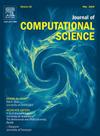A pseudospectral method for time-fractional PDEs with shifted Chebyshev and Lagrange interpolating polynomials on overlapping decomposed domains
IF 3.7
3区 计算机科学
Q2 COMPUTER SCIENCE, INTERDISCIPLINARY APPLICATIONS
引用次数: 0
Abstract
Time-fractional partial differential equations (TFPDEs) are powerful mathematical tools for modeling a wide range of physical and biological phenomena that exhibit memory effects, anomalous diffusion and non-local behavior. These classes of equations are crucial in capturing dynamics where the influence of past states affects future evolution, making them essential in many areas of applied science, such as heat transfer, viscoelasticity and anomalous diffusion. This study proposes a pseudospectral method that combines the weighted sums of the Chebyshev and Lagrange polynomials to numerically approximate the solutions of TFPDEs. The spatial domain is partitioned into uniform, overlapping subdomains, where the solution in each subdomain is represented as a weighted sum of the Lagrange interpolating polynomials. On the other hand, the time domain is treated as a whole without decomposition, and the solution in the temporal dimension is expanded using the first-kind shifted Chebyshev polynomials. We validate the accuracy and performance of the method through a series of test cases, covering both linear and nonlinear TFPDEs in one and multiple spatial dimensions. These examples showcase the method’s capability to handle the computational challenges associated with TFPDEs and underline its potential for broader applications in problems involving fractional dynamics. Specifically, the proposed technique is applied to resolve TFPDE, which models heat transfer on a disk, a problem relevant to modeling heat conduction in circular plates and semiconductor wafers. A time-dependent Gaussian heat source concentrated in a specific region of the disk is introduced to accurately simulate practical thermal diffusion dynamics. The gradual increase of the source term over time offers a more realistic representation of the evolving thermal diffusion process.
在重叠分解域上具有移位切比雪夫和拉格朗日插值多项式的时间分数阶偏微分方程的伪谱方法
时间分数阶偏微分方程(TFPDEs)是一种强大的数学工具,用于模拟各种表现出记忆效应、异常扩散和非局部行为的物理和生物现象。这些类型的方程对于捕捉过去状态影响未来演变的动力学至关重要,使它们在许多应用科学领域至关重要,例如传热,粘弹性和异常扩散。本文提出了一种结合切比雪夫多项式和拉格朗日多项式加权和的伪谱方法来数值逼近TFPDEs的解。空间域被划分为一致的,重叠的子域,其中每个子域的解被表示为拉格朗日插值多项式的加权和。另一方面,将时域视为一个整体而不进行分解,并利用第一类移位的切比雪夫多项式展开时间维的解。我们通过一系列测试用例验证了该方法的准确性和性能,这些测试用例涵盖了一维和多维空间的线性和非线性tfpde。这些例子展示了该方法处理与tfpde相关的计算挑战的能力,并强调了其在涉及分数动力学的问题中更广泛应用的潜力。具体来说,所提出的技术被应用于解决TFPDE,它模拟磁盘上的传热,一个与模拟圆形板和半导体晶圆中的热传导有关的问题。为了准确地模拟实际的热扩散动力学,引入了集中在圆盘特定区域的时变高斯热源。随着时间的推移,源项逐渐增加,可以更真实地反映热扩散过程的演变。
本文章由计算机程序翻译,如有差异,请以英文原文为准。
求助全文
约1分钟内获得全文
求助全文
来源期刊

Journal of Computational Science
COMPUTER SCIENCE, INTERDISCIPLINARY APPLICATIONS-COMPUTER SCIENCE, THEORY & METHODS
CiteScore
5.50
自引率
3.00%
发文量
227
审稿时长
41 days
期刊介绍:
Computational Science is a rapidly growing multi- and interdisciplinary field that uses advanced computing and data analysis to understand and solve complex problems. It has reached a level of predictive capability that now firmly complements the traditional pillars of experimentation and theory.
The recent advances in experimental techniques such as detectors, on-line sensor networks and high-resolution imaging techniques, have opened up new windows into physical and biological processes at many levels of detail. The resulting data explosion allows for detailed data driven modeling and simulation.
This new discipline in science combines computational thinking, modern computational methods, devices and collateral technologies to address problems far beyond the scope of traditional numerical methods.
Computational science typically unifies three distinct elements:
• Modeling, Algorithms and Simulations (e.g. numerical and non-numerical, discrete and continuous);
• Software developed to solve science (e.g., biological, physical, and social), engineering, medicine, and humanities problems;
• Computer and information science that develops and optimizes the advanced system hardware, software, networking, and data management components (e.g. problem solving environments).
 求助内容:
求助内容: 应助结果提醒方式:
应助结果提醒方式:


